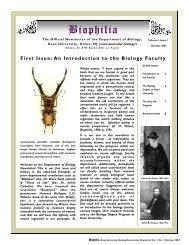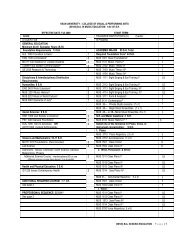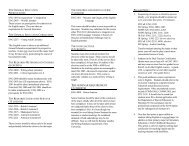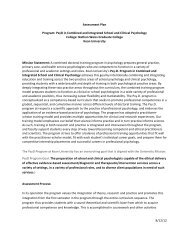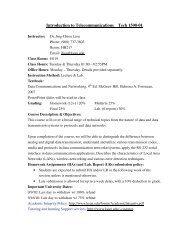GeorGe SeGal - Kean University
GeorGe SeGal - Kean University
GeorGe SeGal - Kean University
Create successful ePaper yourself
Turn your PDF publications into a flip-book with our unique Google optimized e-Paper software.
Art News 1968<br />
12<br />
these hollow men and women are a cast of characters that achieves a kind of blue-collar universality. they indicate<br />
the American yoga of physical and psychological exhaustion.<br />
the bodies, or the imprints of these bodies, exist in three-dimensional space, but their thoughts or their souls<br />
are elsewhere, outside the workday world. Segal is a poet. But he is never oppressive, didactic or “literary.”<br />
He celebrates acceptance. Acceptance, however, must not be read as resignation. Wisdom is contained in the<br />
location of the differences between these apparent similarities.<br />
Segal exploits the language of the body. He does not use the heroic poses of traditional representational sculpture,<br />
but the everyday postures that communicate unconsciously (Indeed, in some systems or anti-systems of thought,<br />
the physical manifestation of a psychological state is the psychological state.) Facial expressions, because they are<br />
created by muscles too subtle to be captured by Segal’s techniques of “mummification” (cloth soaked in wet plaster<br />
is applied directly to the live model), are automatically eliminated, and the body itself, as in dance, bears the burden<br />
of expression. the body, however, even when immobile, is capable of sending a message of great complexity. the<br />
way a man sits, lunges, slumps or arranges himself in a chair contains more history and more truth than all the<br />
personality profiles in the world. the body does not lie. the language of the body—-the relationship between limbs<br />
and torso, muscle tensions, posture and carriage—-offers a rich vocabulary of signs.<br />
the “working-class,” un-Mod tonality of Segal’s iconography is satisfying, not because it approaches certain<br />
Marxist or Ash-can clichés, but because his blue-collar prototypes—-a parking-lot attendant, a girl putting on a<br />
pair of shoes—represent aliterate personalities (as opposed to fashionably normative “post-literate” ones) who<br />
have not ritualized their body language into “manners” that determine “correct” ways of sitting, standing, moving.<br />
Segal brilliantly exposes this forbidden vocabulary of gestures. the bodies of Segal’s faceless (wordless) people<br />
become all face.<br />
What Segal captures with almost infallible grace is the moment of stasis, the significant pose. His figures are<br />
poised between the physical and the spiritual and can be read either way, just as certain Gestalt illustrations can<br />
be read as ladies or rabbits, lovers or pottery. He rarely descends into bathos or social commentary. At his best<br />
and most “poetic” he succeeds in expressing the universal in terms of the particular. What more can we ask?<br />
First printed in Art news, November 1968. Copyright, John Perreault.








